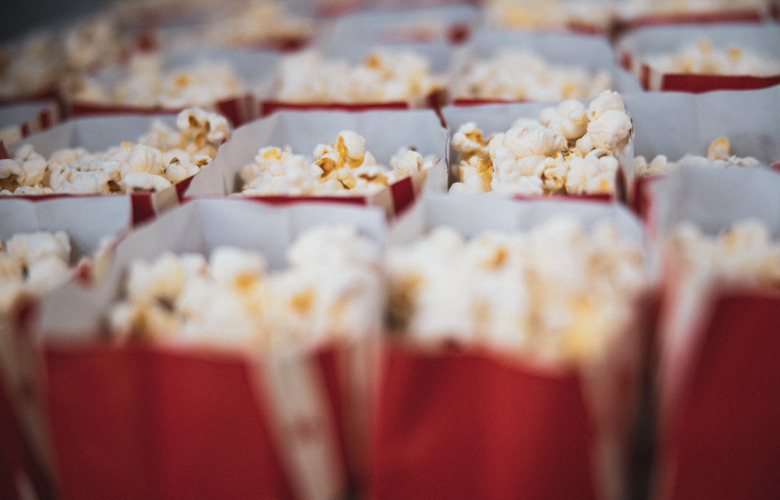
Popcorn. Who here hasn’t munched on it at some point in their lives? It is inextricably linked to entertainment. Not all kinds of course. Connoisseurs of classical music and opera would most likely be aghast at all the crunching and rustling of paper bags during a performance. But, in circus, cinema, as well as during a myriad of other entertainment events, the iconic scent of popcorn will waft through the venue… and, most likely, you won’t be able to resist and will get yourself a bag, too.
What’s your favorite? Mine is the amazing popcorn mix called Chicago Mix. A delicious blend of caramel popcorn and cheese popcorn.
I used to work in a movie theatre during my years at university. And I can tell you it is a special kind of heaven to dig into freshly made salty popcorn, still hot, straight out of the machine.
Loving and producing these little crunchy bits for many years, it was, however, only just recently that I wondered when the very first popcorn was made and why.
At the end of this article, you’ll also have the opportunity to watch a short and quite entertaining video history found on YouTube.
Corn was domesticated about 10,000 years ago in what is now Mexico.
Looking further into how corn was utilized over the millennia, archaeologists discovered that people have known about popcorn for thousands of years.
Fossil evidence from Peru suggests that corn was popped as early as 4700 BC.
To Europeans popcorn was introduced via exploration of the New World. Spanish explorer Hernando Cortes first learned of it during his expeditions to the Americas in 1519.
Through the 19th century in the US, the popping of the kernels was achieved by hand on stove tops. Kernels were sold on the East Coast of the United States under names such as Pearls or Nonpareil.
The term popped corn first appeared in John Russell Bartlett’s 1848 Dictionary of Americanisms.
Unknown to many outside the US, Popcorn is an ingredient in Cracker Jack. In the early years of the product, it was popped by hand.
Popcorn’s accessibility increased rapidly in the 1890s with Charles Cretors’ invention of the popcorn maker. Cretors, a Chicago candy store owner, had created several steam-powered machines for roasting nuts and applied the technology to the corn kernels.
By the turn of the century, Cretors had created and deployed street carts equipped with steam-powered popcorn makers.
Nowadays we associate popcorn mostly with entertainment, especially with going to the movies. Yet for a very long time, popcorn was not featured in entertainment venues.
Rather, the owners of said (at the time rather luxurious) venues did not want the messy fast food in their auditoriums. Other than the obvious discomfort of having the floor covered in popcorn debris, they also wanted to keep noise levels to a minimum.
However, during the Great Depression in the USA, popcorn was inexpensive at 5–10 cents a bag and thus became very popular.
While other businesses failed during those rough times, the popcorn business thrived and became a source of income for many struggling farmers. Including the Redenbacher family, namesake of the famous popcorn brand.
During World War II, sugar rations diminished candy production, and Americans compensated by eating three times as much popcorn as they had before.
The snack became popular at cinemas, much to the initial displeasure of
many of the cinema owners, who thought it distracted from the films.
Their minds eventually changed, however. And, in 1938 a Midwestern cinema owner named Glen W. Dickinson Sr. installed popcorn machines in the lobbies of his Dickinson theatres.
Popcorn was making more profit than selling theatre tickets, and at the suggestion of his production consultant, R. Ray Aden, Dickinson purchased corn farms and was able to keep ticket prices down.
The venture was a financial success, and the trend to serve popcorn soon spread.
Nowadays, an entertainment world without popcorn is unthinkable. The rather addictive snack can be found in movie theatres and circus lobbies all over the world.
The populations of some countries prefer sweet popcorn. Whereas others prefer the salty variety. Often, a mix of both can be found as well.
In our modern times, especially since the introduction of the microwave oven, popcorn has also made its way into our homes.
Many a movie night at home is now accompanied by enthusiastic munching and crunching as the whole family digs into big bowls of home-made popcorn.
In the popcorn industry, a popped kernel of corn is known as a “flake”. Two shapes of flakes are commercially important. “Butterfly” (or “snowflake”) flakes are irregular in shape and have a number of protruding “wings”. “Mushroom” flakes are largely ball-shaped, with few wings.
Butterfly flakes are regarded as having better mouthfeel, with greater tenderness and less noticeable hulls. Mushroom flakes are less fragile than butterfly flakes and are therefore often used for packaged popcorn or confectionery, such as caramel corn.
The kernels from a single cob of popcorn may form both butterfly and mushroom flakes. Hybrids that produce 100% butterfly flakes or 100% mushroom flakes exist. The latter developed only as recently as 1998.
Growing conditions and popping environment can also affect the butterfly-to-mushroom ratio.
So, here you go… No matter where you open your next bag of popcorn, enjoy! And watch out for those butterfly and mushroom flakes!
The History of Popcorn, by History & Intrigue:
When Sailors Were Stagehands – Debunking a Bit of Rigging History
Taking a Closer Look at the Swedish Theatre Landscape


Liam Klenk was born in Central Europe and has since lived on four continents. Liam has always been engaged in creative pursuits, ranging from photography and graphic design, to writing short stories and poetry, to working in theatre and shows. In 2016, Liam published his first book and memoir, 'Paralian'.
Read Full Profile© 2021 TheatreArtLife. All rights reserved.

Thank you so much for reading, but you have now reached your free article limit for this month.
Our contributors are currently writing more articles for you to enjoy.
To keep reading, all you have to do is become a subscriber and then you can read unlimited articles anytime.
Your investment will help us continue to ignite connections across the globe in live entertainment and build this community for industry professionals.